Welcome to 2019 Training, running friends! With the new year upon us, many of us are creating training goals for the year. This blog is loosely a combo of my own experience trying to adopt more strength training as a new training habit mixed with some knowledge from my coaching files in the form of my Top 15 Tips.
New 2019 Training Goals
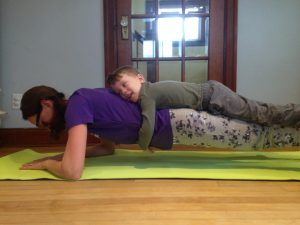
One of my 2018 running goals was to progress my core and body-weight-based strength training into weight training with free weights. I wanted to be stronger. A stronger girl will run faster and be more injury resistant, right? I had been diligent with core and pelvic floor work out of necessity since 2015 but there was definitely room to step it up a notch in both intensity and days of the week.
My spring race goal is the New Jersey Half Marathon on April 28. In mid-December, when I got back to 40km/week after travel and injury, I told myself that it was “go-time!” with both my running training and weight training. It was time to get back to training that often includes 3 x 5am wake ups to run at 5:15am and my new goal to do weight training 3 times per week.
In mid-December and earlier in January, my training took willpower effort. I looked forward to a point down the road where it would feel automatic. Where you perceptibly switch from “am I going to run at 5:15am tomorrow?” to not thinking or considering any other possibility other than running at 5:15am tomorrow. You are just going to do it. My lengthy running history tells me that I will get to that point with the 5am run. I hoped that I had done enough things right with the weight training to get there with that too.
On January 20, I’m there with both. They are now my habits. I no longer question whether I go or not. I just go
So how do you get there? To habit?
A habit is a behaviour or an action that we do automatically and regularly without consciously thinking about it. So running without spending 15 minutes wrestling with the desire to stay on the nice warm and soft sofa. Heading to your gym or home workout space without thinking and wondering all day if you are really going to do it or if the tv or the cleaning of the bathroom or the wine is going to win.
“Habit Expert” Charles Duhigg (author, NY Times reporter) says that a habit is made up of a group of cues, a reward and a routine.
So it seems reasonable that these things will be ingredients in a habit recipe.
If it’s a recipe, how long do you bake it for?
I did a quick google search this week on how long it takes a habit to form. Here’s what I found in the 10 or so pages that I opened up:
- 21-30 days
- 84 days
- 4-6 weeks
- 2 to 8 months
- Minimum of 21 days
- 66 days exactly
- 66 repetitions of the behaviour
- All the way to 200+ days
Helpful? Haha! So it stands to reason that a habit takes “a period of time” to develop and let’s just leave the timeframe at that.
There are things that you can do to help make your desired behaviour or habit become more automatic. The internet is full of advice on this. Here is a collection of 15 things that have worked for me.
Coach Erin’s Top 15 Tips:
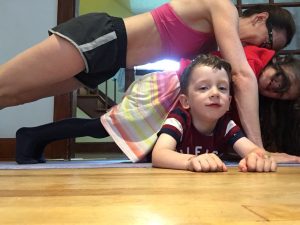
1.Start small. And set realistic goals. I didn’t pop out 3 weight training sessions per week by starting there. For me, I had to build to that over 2+ years. I am a runner and the kind that is not a lover of the gym or strength. Given extra training time, I would rather just run more.
I started small with a goal to do one core session per week. I would do it Sunday morning while my kids watched cartoons. I felt good about that. Then I added one core session and one strength session using bodyweight exercises per week. I did that for almost a year, sometimes meeting my goals, sometimes not.
Then I wanted to use weights but I didn’t own any. So I took the summer of 2018 and told myself that if I could prove that I could do two strength sessions per week, I could buy myself a set of home free weights. I met that goal. The reward was purchase of dumbbells at Canadian Tire at the end of sumer and the ability to be ready to set a goal of 3 sessions per week.
2. Find and name your motivation. Getting in touch with the reason why you want to adopt a new habit is logical, right? It might help when willpower is low because you can cycle back to it. Why do I want to add more strength training? Because I want to both be stronger and run faster. Why do I want to run at 5am? Because I want to run fast in the spring. Why do I run? That’s an entire other saga. I was motivated to adopt more strength training now because I was inspired by the runners who I coach. Runners like Meghan, Doreen and Crystal were fitting in way more strength training that I was. In watching them, I grew more motivated to be stronger too.
3. 10 Minutes at a Time. When you’re struggling with willpower and motivation in the moment, it’s an option to tell yourself that you only have to do 10 minutes. You can get out the door and tell yourself that you only have to run for 10 minutes. Then you can decide if you are going to continue or head back to the sofa. You can go to your strength mat for 10 minutes. Then you can decide if there’s going to be more.
Sometimes I head out to run a 2km loop around my block and I tell myself that I may stop after the loop. Often, there is more when you get to 10 minutes. But even if you complete your run at 10 minutes, a run is a run and 10 minutes is better than zero.
4. Stay patient while starting small. And then be more patient. Running at 5:15am isn’t new to me but it almost feels new again each training cycle after I get out of the habit. Running 5 days per week isn’t new to me. But as has been the case the last few years, I’ve been battling injury and the time between training cycles has been so long that I lose most of my “running-fast” fitness between cycles. My “running-fast” fitness is currently not available. I need to be patient. That fitness is somewhere down the road. I will get it back. There are no shortcuts and trying to overreach and run beyond my limits now will just set me back. I want to be the Erin who nails workouts and runs fast. I will be her again but I can’t be her right now. I build to her. These early training blocks are exercises in patience.
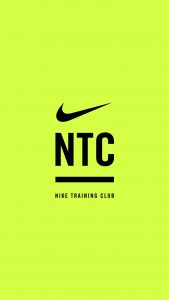 5. Follow a Plan. Whether it’s a plan that you write yourself or a boxed plan from the internet or an individual plan from a coach, it will help your accountability. I coach other athletes but I don’t want to coach myself. I rely on Coach Lee with the Halifax Road Hammers. He has my long run distance and weekly mileage laid out for me through New Jersey race day. I have the numbers on paper. I meet the numbers each week. I respond to that accountability.
5. Follow a Plan. Whether it’s a plan that you write yourself or a boxed plan from the internet or an individual plan from a coach, it will help your accountability. I coach other athletes but I don’t want to coach myself. I rely on Coach Lee with the Halifax Road Hammers. He has my long run distance and weekly mileage laid out for me through New Jersey race day. I have the numbers on paper. I meet the numbers each week. I respond to that accountability.
For my strength training, I am using the free Nike Training Club app which is super well done and fun. I cycle through full body, abs and arms and glute workouts.
6. Somehow See Your Success. Like get a pretty training journal. The Believe journal is popular with my Love Training More athletes. This isn’t a strategy that I use but it sure is effective for some people. My non-journalling soul is always a little bit envious when they post their end of year journal pics.
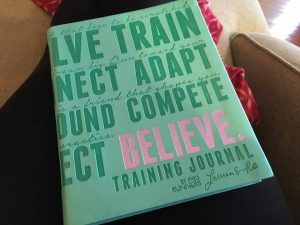
7. Build your routine. The smart people say that “Morning people aren’t born, they are built” and “Make the healthy choice the easy choice.” Shaping your habit, be it running or strength training, around the same context, same time and same pace may work.
Lay out your gear for morning runs so that it’s easy. I hang my gear on the cast iron radiators in my almost 90 year old house and it’s toasty warm for me when I pop out of bed. I go so far as untying my running sneakers the night before. You could build some favorite routes and run them. You could decide what day and time of day is for strength and stick to it. Choose your favorite gym music and use it.
You can make your routine fun and enjoyable. Before winter training really set it, I bought myself 5 pairs of new wool winter running socks (Costco!) so that socks would be easy. Doing laundry or not having warm socks could not be my excuse not to get up and run.
I set up my workout space in our basement and made it an appealing space to be in. I bought two new bras on Boxing Day sales so it would be more fun. The Lululemon “we made too much” online site is danger to me! But you don’t need to spend lots of $, you can pick up gear at Winner’s, Value Village, Run Nova Scotia’ online market page etc. Gear for me is fun, motivating and helps my routine.
My kids love to watch and help me do my Sunday workout. It’s our thing. And in turn, they get 10 minutes of cartoons on the special downstairs tv once I’m done streaming my Nike app on the screen.

8. Use social media. Strava, the social media platform for runners, can be a powerful motivator. The praise in form of kudos and the social capital gained both feel good. We are humans and we like to do things that feel good. If this feels good for you, go for it.
Sometimes there’s a concern about perception of the audience, “what will my social network think if I’m talking about running all the live long day.” Here’s what I say: those people can look away. You don’t need to police your (healthy) activities and narrative based on what you think other people think. If this healthy expression feels good for you, go for it.
I got a fancy new Garmin 645 Music over Christmas and I’ve been using it to track all of my training minutes and I’ve been letting it automatically upload my strength workouts to Strava because that external motivation works for me. I like seeing all of the training hours each week. If you don’t like, don’t look.
9. Beat boredom. There are so options for you to use to beat boredom on the run and in the gym. Podcasts. Music. Audiobooks. I’m not a running purist. I don’t preach listening to the sound of my breath, my own footfalls and the sounds of nature at all cost and at all times of the training week. 5:15am is often cold and lonely and quiet. I love podcasts and music. My podcast favs are Running 4 Real and The Shakeout Podcast by Canadian Running. I also love the Three Friends podcast who’s music podcasts are mash-up jams, awesome running tunes. I love that I never know what beats are coming next. My Nike Training App plays my music for me. I’m currently really into the “Into the Spiderverse” Soundtrack.
10. Harness your own definition of success. This one is powerful for me. My goal is to run fast in the spring and that will be success. Success isn’t tied to a race time, it’s simply getting as fit as possible and toeing the line ready to rip (see last January’s post on setting race goals). I believe that running 5 days a week and strength training 3 times per week is going to help me meet that goal. So I will do those things (as long as my body is healthy). I won’t leave a training week at 4 running days because 4 is not 5. I want 5. Because I believe 5 is what I need for success. It works.
11. Make it joyful. Feel good and enjoy the journey.
Something called a Positive Feedback Loop exists. It looks like this:
- Run or strength train
- You see benefits like improved endurance, faster pace, more energy, stronger body, you sleep better, you get kudos. Etc. etc.
- You feel good.
- By feeling good, you are more likely to go back to step 1.
Now for my crew who train in winter climates, the winter doesn’t always feel good. But you can be mindful and intentional to see one beautiful thing on each run. Even when it’s frigid, the sun is still shining. The ice looks pretty on trees. Sometimes you are the one to place the first footprints in freshly fallen snow. The city belongs to you alone at 5:15am. No one needs you for this one hour time block, it’s all for you. Your friendships deepen on the run side by side with no entertainment in form of screens, just dialogue. Etc. Etc. Feed the positive feedback loop. Enjoy the journey. If you struggle with this, follow our Love Training More runner Sacha, @mindful_ocean_girl, on Instagram. She has one of the most intentionally positive accounts I know. Channel her.
Feeling good in my strength training has been easier than expected. I’m having a grand time watching my body quickly adapt on 3 workouts per week. I can do things that I would not have thought possible 2 months ago. I can do boat pose with leg extension, my core is strong enough now. I can do the one-armed planks. I can do the deadweight airplane. This all feels good.


When my kids “help,” I find joy in this time together. They each have 1 lbs pink weights. My 4 year old recently told me that he needed more wights and in different colours. I explained that one set of dumbbells was plenty at age four. I asked my 6 year old who the strongest mom she knew was. She replied, “Ms Murray,” her grade 1 teacher (hehe).
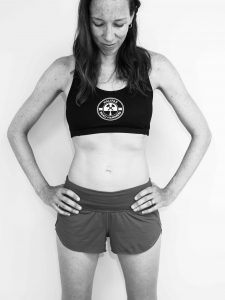
12. Rewards. You are working hard. You deserve rewards and your rewards can be motivating. Over time, I’ve used lots of kids of rewards:
- When I get through this training block, I may purchase a new iTunes album or this new piece of running gear.
- I can sign up for this race.
- I will reward myself with my most favourite and more expensive wine after nailing a Saturday workout.
The direct benefits of your training are rewards too.
- My developing strong body is a reward.
- Previously named, seeing progress and doing things like boat, one-armed plank and airplane with deadweight that I didn’t think I would be able to do are rewards.
- When I got strong enough, I bought the next set of dumbbells at Canadian Tire just before Christmas. I’m now looking forward to buying the next set when I’m ready.
- Moving up in paces is a reward. Along with nailing workouts.
13. Snacks. My 4 and 6 year old kids know that Snacks are King. Training needs fuel. Take a small block of time and prepare fun and healthy snacks that you enjoy for pre and post training fuel. For a period of time, my Halifax Road Hammer teammate Christy and I were emailing each other weekly about favorite new snacks because we both used Sunday afternoons to bake. My favs include energy bites with honey/chocolate chips/raisins/cinnamon, Shalane’s SuperHero Muffins from Run Fast, Eat Slow and Shalane’s Sweet Potato Breakfast Cookies.
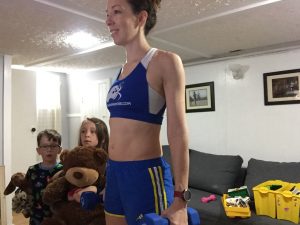 14. Harness the Long Game if that works for you. The long game works for me. I think about how this training session, each training session, bring me closer to my spring goals.
14. Harness the Long Game if that works for you. The long game works for me. I think about how this training session, each training session, bring me closer to my spring goals.
My young Halifax Road Hammer teammate Will said to me last weekend, after watching my Strava feed: “I could never get up that early.” I reply, “If I want to run fast in the spring, this is what I do.” End of conversation.
15. Celebrate. Celebrate all of the milestones. Down week is something that I celebrate. Like many coaches, both the Love Training More plans that I write and my Halifax Road Hammer training plan comes in a format of 3 weeks of build and 1 step-back or down week. I celebrate making it to each down week. It represents a successful 4 week block. I also enjoy easy runs that a shorter and don’t always require the 5am alarm,I can squeeze some this shorter mileage in after work or at lunch.
Lots of these tips are interrelated. Celebrating feels good. It also feeds the positive feedback loop. This is connected to being joyful, right? This weekend, I was downright joyful to find myself flooded with workout pain and suffering, the kind that burns so good. I worked so hard at rehabbing my foot injury to be healthy enough to hurt this way. I celebrated being able to hold onto my longtime training partner Damian in the workout after longing to be with him over my recovery period.
That’s a lengthy collection of 15 tips. If I knew exactly what would work for an individual athlete, I would tell them exactly what to do. They would become wildly successful athletes. I would be a wildly successful coach. But it doesn’t work that way, does it? We each need to find out for our own selves what will work and then we gotta get to work doing it, consistently, regularly, until it becomes habit.
I wish you luck finding what works for you!
My old blog posts are a a historical narrative of my running life. I was curious to see what I was doing 8 years ago when I started my blog. I was writing this Ode to Winter Running in 2011 while training for my third Boston Marathon.




